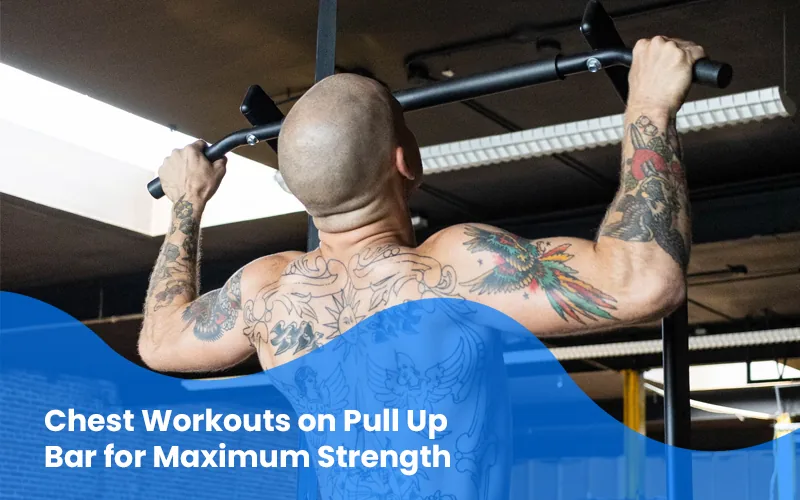
Gone are the days of having to hit the gym or pick up expensive equipment to get a good workout. All you need is a pull-up bar and your own body weight to help tone, strengthen, and build muscle in your chest. This article will provide an overview of chest workouts on pull-up bars and which exercises you can use. With some simple modifications and variations, these exercises can be adapted for any fitness level from beginner to advanced.
Pull-Up Bar Basics
Pull-up bars are an essential piece of fitness equipment that can be used to target multiple muscle groups and improve overall strength. When using a pull-up bar, it is important to ensure proper form and technique in order to maximize the benefits of your workout.
To begin, make sure you have chosen the 4 weeks for everybody right size bar for your height and body type. This will help you maintain proper form throughout your workout and prevent injury. Next, adjust your grip so that it is comfortable but secure. For beginners, it is recommended to start with a wide grip before narrowing as you progress. Finally, use controlled movements when performing pull-ups and avoid jerking or swinging motions as this can cause injury.
When done correctly, pull-ups are an excellent way to build upper body strength while also engaging core muscles for stability. With regular practice and good form, you can expect to see improved strength and definition in your arms, back, and shoulders over time.
Proper Form and Posture
Proper form and posture are essential when performing chest workouts on a pull up bar. Here are some tips to help you get the most out of your workout:
First, make sure your grip is wide enough to target the chest muscles. Too narrow a grip will work the arms more than the chest. Secondly, focus on engaging your core and keeping your body in a straight line from head to toe as you perform each repetition. This will ensure that you are using the proper form and not putting unnecessary strain on your lower back.
Finally, be sure to keep tension in the chest muscles throughout each rep by slowly lowering yourself down until your arms reach a 90-degree angle before pushing back up. This will help activate the chest muscles more effectively and prevent injury. By following these tips, you can maximize the effectiveness of your chest workouts with a pull up bar while avoiding any potential injuries.
Types of Chest Workouts on Pull Up Bar

Pull-up bars are a great way to add a variety of chest workouts to your routine. Here are some exercises you can do with a pull-up bar to target the chest muscles:
Workout 1: Classic Pull Ups
The classic pull up is one of the most effective exercises for building upper body strength. Here are the steps to performing a proper pull up:
- Begin by gripping the pull-up bar with an overhand grip, hands slightly wider than shoulder-width apart.
- Engage your core and glutes to stabilize your body as you bend your elbows and pull yourself up towards the bar until your chin is above it.
- Slowly lower yourself back down to starting position and repeat as desired. Make sure to keep your body in a straight line throughout the exercise and avoid swinging or jerking movements.
Workout 2: Incline Pull Ups
Incline pull-ups are great chest workouts on pull up bar to build upper body strength and improve your fitness level. Here's a step-by-step guide to performing incline pull-ups:
- Start by setting up an inclined bar at chest height or slightly higher. Grasp the bar with both hands, palms facing away from you, and your arms fully extended.
- Pull yourself up towards the bar until your chin is above it. Keep your core tight throughout the movement and focus on engaging your back muscles as you pull up.
- Lower yourself slowly back down to the starting position, taking care not to let your arms straighten completely until you reach the bottom of the movement.
Repeat this motion for 10-15 reps for 3 sets, then rest for 1 minute before moving on to the next exercise in your routine. With regular practice, you should start seeing results in no time!
Workout 3: Decline Pull Ups
The first step to declining pull-ups is to practice negative pull-ups. This involves using a bench or box to assist you in lowering your body from the top of a pull-up position.
- Start by standing on the bench and slowly lower yourself down until your arms are fully extended.
- Hold this position for 2-3 seconds and then return to the starting position.
- Practice this motion 3-4 times, with rest periods between each repetition.
The next step is to use resistance bands while doing pull-ups. Attach one end of the band around a bar and loop the other end around your foot or ankle. This will help you reduce the amount of weight you’re lifting, making it easier to do pull-ups with good form. Start by doing 1-2 sets of 6-8 reps, increasing the number of reps as you get stronger.
Workout 4: Wide Grip Pull Ups
Wide grip pull-ups are great chest workouts on pull up bar for targeting your upper back muscles.
- Start by standing directly underneath the pull-up bar with your hands slightly wider than shoulder-width apart. Make sure your palms are facing away from you, and grip the bar firmly.
- Keeping your core tight and engaging your back muscles, begin to pull yourself up towards the bar until your chin is above it. Keep your elbows close to your body as you do this.
- Hold this position for a few seconds before slowly lowering yourself back down to the starting position. Make sure to keep tension in your muscles throughout the entire movement, and repeat for 8-12 reps.
Workout 5: Close Grip Pull Ups
Close grip pull-ups are an effective exercise for building upper body strength and can be done with just a bar. Here is a step-by-step guide to help you perform close-grip pull-ups correctly:
- Start by standing beneath the bar with your hands slightly wider than shoulder-width apart. Reach up and grab the bar with an overhand grip.
- Pull your body up towards the bar, keeping your elbows close to your sides and shoulders back as you lift yourself up. Make sure to keep your core tight throughout the motion.
- Once your chin reaches above the bar, pause for a moment before slowly lowering yourself back down until your arms are fully extended again. Repeat this motion for as many reps as desired.
By following these steps, you can effectively perform close-grip pull-ups and reap the benefits of this exercise!
Workout 6: Reverse Grip Pull Ups
Reverse grip pull-ups are effective chest workouts on pull up bar to build back strength and muscle mass. Here’s a step-by-step guide for performing this exercise:
- Start by positioning yourself on a pull-up bar with your hands shoulder-width apart, palms facing away from you. Make sure your arms are straight and your feet are off the ground.
- Begin to pull yourself up until your chin is above the bar, then slowly lower yourself back down to the starting position.
- Repeat this motion 10-15 times or as many as you can manage with proper form. Be sure to keep your core tight throughout the exercise and focus on using your back muscles rather than momentum to propel yourself upwards.
By following these steps, you can safely and effectively perform reverse grip pull-ups and build strength in your back muscles over time.
Safety Considerations

When performing chest workouts on a pull-up bar, safety should always be the top priority. To ensure your safety, make sure to use a sturdy and secure bar that is designed for the exercises you intend to do. Additionally, it is important to properly warm up and stretch before beginning any exercise routine. This will help reduce your risk of injury by preparing your muscles for the workout. Finally, it is important to take breaks when needed and not overexert yourself. Listen to your body and stop if you feel any pain or discomfort.
Progressing Chest Exercises on Pull-Up Bar
Progressing chest exercises on a pull-up bar can be done by adding weight to your body or increasing the number of reps. To add weight, you can use a weighted vest or ankle weights. This will make the exercise more challenging and help you build strength in your chest muscles.
Another way to progress is to increase the number of reps. Start with 1-2 sets of 8-10 reps and gradually increase the number of sets and reps as you become stronger. You can also try doing pause reps, where you hold for a few seconds at the top of each repetition before slowly lowering yourself down. This will help you build muscle endurance and improve your form.
Finally, you can also vary the grip width on the pull-up bar to target different areas of your chest muscles. A wide grip will work your outer chest, while a narrow grip will work your inner chest muscles. Experiment with different grips to find what works best for you.
Conclusion: Maximize Your Chest Workouts on Pull Up Bar
Maximizing your chest workouts on a pull-up bar is a great way to build strength and muscle. It can be done with minimal equipment and space, making it an ideal choice for those who don't have access to a gym. There are several exercises that can be done on a pull-up bar that target the chest, such as wide grip pull-ups, close grip pull-ups, and dips.
To maximize your chest workouts on a pull-up bar, focus on controlling each rep and increasing the resistance by adding weight or doing more reps. Additionally, incorporating different angles into your exercises will help to keep your muscles challenged and engaged. Finally, make sure you are using the proper form to ensure you get the most out of each exercise and reduce your risk of injury.